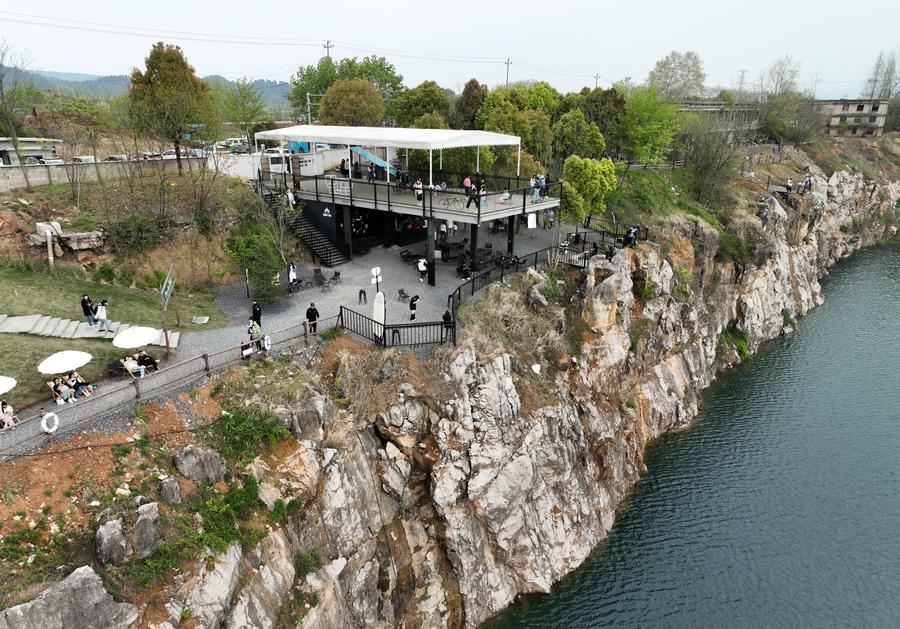*As one of the world’s most mineral-rich nations, China contains over 150,000 mines occupying millions of hectares of land.
*The country has implemented multiple measures to advance the ecological rehabilitation of abandoned mines in recent years, aiming for win-win outcomes in terms of ecological, economic and social benefits.
*By the end of 2024, over 333,300 hectares of abandoned mines had been rehabilitated — including 26,200 hectares newly restored in 2024 alone.
JINAN, May 27 (Xinhua) — Tianchi Lake at Baihu Mountain in east China’s Shandong Province features expansive water shimmering with rippling blue waves, and pale purple paulownia flowers blooming along its steep rocky shores.
It’s hard to imagine that this tranquil and beautiful landscape was once a barren quarry pit. “Windstorms used to whip up dense dust clouds, obscuring the colors of leaves and flowers,” recalled 62-year-old villager Wang Yunhe in Hetaoyuan, a town with 22 mountains and an estimated 1.19 billion tonnes of rock reserves.
As one of the world’s most mineral-rich nations, China contains over 150,000 mines occupying millions of hectares of land. Upholding the concept that clear waters and green mountains are valuable assets, the country has implemented multiple measures to advance the ecological rehabilitation of abandoned mines in recent years, aiming for win-win outcomes in terms of ecological, economic and social benefits.
ECOLOGICAL TRANSFORMATION
According to Shang Baoling, a former local official, quarrying had become the dominant industry in Hetaoyuan since the 1990s. Nearly 50 lime kilns were built, with over 2,000 villagers relying on stone mining for their livelihoods.
Rapacious mining boosted local economies temporarily, but later caused significant ecological damage. “These mountains, originally over 180 meters tall, were excavated to depths exceeding 40 meters below ground level — ultimately transforming verdant peaks into desolate quarries,” Shang said.
In 2015, authorities of Juye County, which administers Hetaoyuan, enacted a comprehensive mining ban, shuttering all quarries and lime kilns. Years of dedicated reforestation have since transformed 18,000 mu (1,200 hectares) of mining wastelands and slopes into thriving ecosystems, where crabapple, cherry blossoms, paulownia flowers and other flora now bloom in seasonal cycles.
Many greening workers employed in this effort were former miners from local villages. “Several villagers told me the changes have been tremendous,” Shang added.
Such transformations are occurring across China. By the end of 2024, over 333,300 hectares of abandoned mines had been rehabilitated — including 26,200 hectares newly restored in 2024 alone.
This year’s government work report said China will “accelerate the green and low-carbon transition,” listing “strengthening ecological conservation and restoration” as a key priority.
AGRICULTURAL GOLDMINE
Nationwide, abandoned mines with geographical and resource advantages are being repurposed for agricultural and other industrial development, creating new economic opportunities for local residents. Taobei Village in Shandong’s capital city of Jinan, for example, rehabilitated its abandoned quarry, a low-lying area littered with rubble, turning it into a medicinal herb cultivation base several years ago.
“We have developed cultivation of over 10 medicinal herbs, including astragalus and Chinese sage, with an annual production capacity reaching 4 million plants,” said Tao Changguo, director of the village committee.
Local authorities have also introduced specialized planting cooperatives, establishing processing workshops for medicinal herbs, and facilities for sorting, packaging and fresh storage. These initiatives have boosted local employment while generating more than 200,000 yuan (about 27,825.7 U.S. dollars) in additional annual income for the cooperatives.
In 2008, as local environmental restoration efforts began, a long-abandoned mining pit in China’s eastern coastal city of Qingdao found new life as a vineyard and winemaking hub, thanks to its prime location on the same latitude as Bordeaux in France.
“The barren yet well-draining soil here enhances grape acidity and phenolic content, while the scattered rocks in the earth contribute abundant organic minerals,” said Yan Zhigang, deputy general manager of a local wine company.
According to Yan, the company’s vineyard spans approximately 3,000 mu of reclaimed mining land, where grapes are cultivated on former wasteland and abandoned pits have been repurposed into wine cellars. With an annual production volume of nearly 500,000 bottles, their wines are exported to multiple countries and regions including Europe, Southeast Asia and Japan.
TOURISM BOOM
After two decades of relentless efforts, Anji, a small county in east China’s Zhejiang Province, is now successfully transforming its ecological advantage into tangible wealth.
Launched in 2022, Deep Blue Coffeehouse, located on a 300-mu disused mine near a natural lake in Hongmiao Village of Anji, has now become a social media sensation, drawing 600,000 visitors yearly and earning 20 million yuan in its first year.

This Scandinavian-style outdoor cafe made headlines in 2024 when it set a new national record for single-day sales at an independent coffee shop — serving an impressive 8,818 cups of coffee in just 24 hours.
“It’s less about selling coffee and more about selling the scenery and leisure itself,” said Cheng Shuoqin, owner of the coffee shop.
In recent years, with the deepening integration of ecological restoration and cultural tourism, an increasing number of once-barren industrial sites have been revitalized through scientific planning and innovative design. These transformed spaces now serve not only as eco-parks and tourist destinations but also feature diverse business models, such as countryside-style farm stays, thrilling amusement parks and immersive performance venues.
At the Huaxia City Scenic Area, located in the city of Weihai in Shandong, Zhou Liming was driving tourists through lush forests and flower fields. A resident from a nearby village, Zhou currently works as a sightseeing vehicle operator in the area. According to Zhou, this area was once nothing but a quarry pockmarked with 44 mining pits of various sizes.
Since 2003, Weihai has implemented a comprehensive initiative across abandoned mining zones as a strategy for sustainable development. Through reclaiming nearly 4,000 mu of devastated mountains, constructing 35 reservoirs and planting 12.27 million trees, this transformed landscape ultimately gave birth to a thriving tourist resort.
In the scenic area, an abandoned mining ravine has been transformed, featuring masterpieces of Chinese calligraphy from successive dynasties carved into its towering cliff walls on both sides. A preserved mining village and pit relics remind visitors of the importance of ecological conservation. At a rehabilitated mining site, audiences can now watch an immersive live performance aboard a giant ship, with the actual mountains, water and sky forming a breathtaking natural backdrop.
In 2024, the scenic area welcomed 2.04 million visitors, generating total revenue of 124 million yuan. During this year’s May Day holiday alone, it attracted 82,000 tourists with holiday earnings reaching 6.65 million yuan.
“Now, driving a sightseeing vehicle in the scenic area earns me 60,000 yuan annually. This is the good life that our lush mountains and clear waters have brought us!” Zhou said. ■
(Reporting by Cui Enhui and Yuan Min; Video reporters: Zhu Xiaoguang, Zang Dongming and Zhang Hao; Video editors: Wang Houyuan, Roger Lott and Zhao Xiaoqing.)

